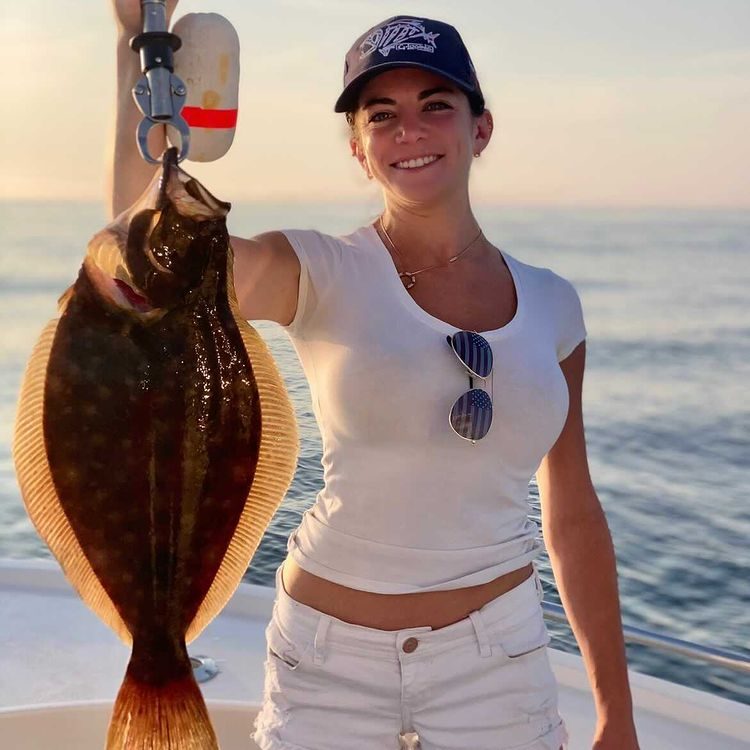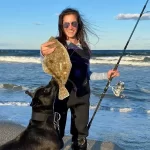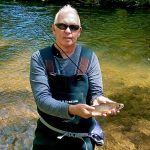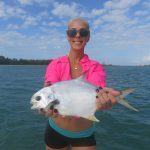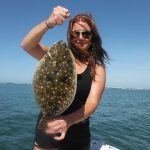Fishing for Fluke, the Ultimate Guide!
The article will thoroughly cover fishing for fluke. Fluke are a very popular game fish that are found from the mid Atlantic north to Canada. They are a member of the flatfish family, very similar to flounder. Fluke fight hard and are prized by anglers for their incredible fillets.
Fishing for fluke
Just like with other forms of fishing, in order for anglers to be successful fishing for fluke, the habits of the species must be studied. Anglers must understand where they live and what they feed on, along with any seasonal migrations. These factors will be covered in this article.
Fluke are the ultimate ambush predator. They have perfect camouflage which allows them to blend into the bottom. Fluke will bury into the sand, with just their every protruding. Both eyes face up as well. Any unsuspecting prey that washes by with the tide can be instantly devoured.
Fluke can be found in the inshore bays as well as the open Atlantic Ocean. They will usually be found near some type of structure. This can be a rocky ledge, wreck, jetty, dock, or bridge. Any type of structure that breaks the current flow and holds bait will attract fluke and other game fish.
Tides and current are also important factors to take into account. Shallow bays may not have enough water on lower tide stages. Tidal flow will also position fish. Fluke will usually be found right on the edge of the structure as it transitions to sand. Inlets and bridges are top spots for fluke fishing.
Best fluke fishing tackle
Anglers have a couple of choices when it comes to the best rod and reel combination for fluke fishing; spinning or conventional. Both have advantages and disadvantages. Spinning tackle is great when longer casts are required or when light weights and lures can be used.
Johanna likes to use spinning tackle. Since she mostly fishes with jigs, the lighter tackle allows her to fish longer without getting tired. Joanna also thinks lighter tackle results in more bites when the fish are finicky. Her favorite fluke fishing rig is a 7′ G Loomis rod with a 4000 Quantum reel loaded up with 20 lb braided line.
Conventional, or baitcasting tackle is a great choice for many anglers fishing for fluke. This is especially true when fishing from a boat where casts are not required. Also, conventional tackle is best when fishing in strong current where heavy weights are required to hit the bottom. This goes for situations where very large fluke are an option as well.
Best fluke fishing rigs
Since fluke live and feed on the bottom, that is where the bait or lure needs to be presented. The most popular bottom fishing rig for fluke is some variation of a “fish finder” rig or a “Carolina rig”. Both of these are excellent coasting from shore as well as drifting from a boat.
The rig is pretty simple. A sinker is threaded on the main line. Sinker weight is determined by the strength of the current and depth. Anglers should use the least amount of weight that will hold bottom. Fish finder rigs are nice because they allow for quick weight changes. Bank sinkers or egg sinkers can be used.
A swivel is then tied on the running line. This stops the weight from sliding and allows for a leader to be attached. A 3′ long flourocarbon leader of 40 lb test works well. A 3/0 to 8/0 (depending on fish and bait sizes) circle hook or Kahle hook finishes off the rig. Some anglers add a spinner for extra flash. As the sinker bounces off the bottom, it kicks up little puffs of sand and the bait trailing behind will get the attention of the fluke.
The second rig that anglers fishing for fluke use is some type of “high/low” or “spreader” rig. This uses multiple hooks which allows anglers to present multiple baits at different distances above the bottom. Rigs with wire frame arms can be purchased or anglers can tie their own.
Best baits and lures for fluke fishing
Fluke can be caught by anglers using any of the regular bottom fishing baits including clams, bloodworms, and crabs. However, the vast majority of fluke are caught by anglers using squid, strips of cut bait, or minnows (live or dead). These three baits will cover just about every situation an angler fishing for fluke will encounter.
Squid works well and is easy to obtain and use. Johanna likes to cut 6” strips that start at 1 1/2” wide and taper to a point. The bait is hooked in the wide portion and this results in the bait fluttering very naturally in the current. Strips of cut fish are used in much the same manner.
One trick that Johanna likes to do is to cut strips from the outside edge of the white side on the first legal fluke that is caught. This bait is super fresh and thin and looks incredible in the water! Any fish that is legal to keep can be cut into strips, with the white belly sections generally preferred.
Fluke feed extensively on bait fish. Therefore, minnows are an excellent bait. Live minnows work well, but frozen minnows are more convenient and will often do the trick. The minnow species will vary by region, mud minnows and killies can be caught in traps or nets. Anglers can also purchase them at shops. Just about any minnow will produce fluke. Crabs can be an issue when using live minnows.
Fishing for fluke with jigs
The most productive artificial lure for anglers fishing for fluke is a jig. The reason for this is that a jig can be presented right on the bottom, where fluke live and feed. A jig really is a great way to fish for fluke as the weight and hook are combined in one unit. Johanna likes a 30” piece of 25lb flourocarbon leader.
Like many anglers in the region, Johanna loves the S&S jigs. She uses it with a Gulp bait or a strip of squid or cut bait. She likes to tie a teaser 8” up the line on a 6” dropper.
White bucktail jigs have been producing fluke to decades. 2 ounce to 4 ounce jigs will cover most situations, though anglers may need to go heavier in swift currents. The Spro line of bucktail jigs works very well, they use quality components. The jig can be tipped with a Gulp bait, soft plastic trailer, strip of cut bait, or minnow.
Fluke fishing techniques
Fluke fishing is not all that complicated. However, there are nuances that will result in the trip being more productive. Most anglers drift when fishing for fluke from a boat. This is an efficient method as the anglers cover a lot of water while the bait stays in the strike zone the entire time.
Anglers should set up the drift in a spot with the wind and tide moving in the same direction. This is very important! Trying to fish with the wind pushing one direction and the current running the opposite way can be very frustrating. Also, it is best to try and drift areas that have ledges and depth changes.
It is also important that anglers stay in constant contact with the bottom. This means changes in weights will be required as the tide ebbs and flows. The sinker or jig should be bouncing just off the bottom as the angler slightly raises the rod. When jig fishing, a bit more action can be imparted.
There are certainly times when anglers fishing for fluke will want to anchor. Modern GPS trolling motors have made this much easier as the boat can be positioned exactly where desired. Drifting over structure such as wrecks will result in snags. The boat should be positioned up-tide of the structure, right on the edge where it transitions to sand.
Bridges are also fluke fishing hot spots! Anglers need to heed current laws as some places prohibit anchoring under or even fishing bridges. Also, anglers in boats should be courteous to those fishing from the bridge.
Surf fishing for fluke
Anglers who do not have a boat can still enjoy success when fishing for fluke. Surf fishing for fluke can be productive as well. The same rigs and baits are used. Anglers do tent to use tougher baits that can withstand the long casts. Most surf fishing anglers prefer two hours before and after the high tide, especially if they occur at dawn or dusk.
Surf fishing tackle is a bit different than the rods used on boats. The rods are longer, between 10′ and 15′ long, with larger reels. This allows for the bait to be cast out over the breakers, though fluke will often be caught in the “wash”, right up close to the beach.
Jetties are also excellent spots to fish for fluke. Fluke are well known to be fond on inlets, the current makes for a natural feeding station. Those strong currents can make fishing difficult, be prepared for snags!
Fluke fishing can result in a terrific meal!
One of the best aspects of fishing for fluke is that they are among the finest eating fish that swims! They can be prepared in a variety of ways. One classic preparation is to lightly cover the fillets with olive oil, salt and pepper to taste, place thin lemon slices on top, and bake in a hot oven. –
Fried fluke is excellent as well. Anglers can coat the fillet in their favorite breading and deep fry in oil or pan fry in a butter/olive oil mixture. Ambitious cooks will do a fluke fillet stuffed with crab meat; fantastic! No matter the preparation, spices and marinades should be limited so as not to overpower the mild and delicate flavor.
In conclusion, this article on fishing for fluke will help anglers catch more of these popular saltwater game fish!

